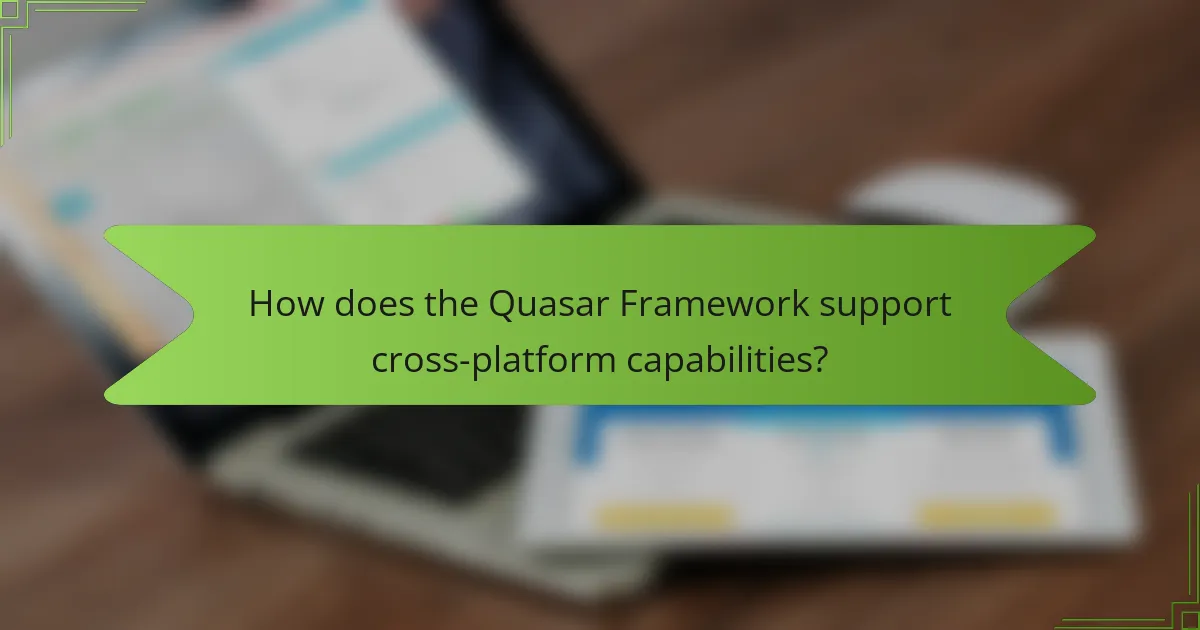The Quasar Framework is an open-source tool designed for building responsive web applications across multiple platforms, including web, mobile, and desktop. It utilizes Vue.js to provide a robust structure for user interfaces and offers a rich set of UI components that are adaptable for various devices. Key features of Quasar include server-side rendering, progressive web app support, and a command-line interface that streamlines the development process. The framework also supports deployment through Cordova and Capacitor, enhancing its cross-platform capabilities. With extensive documentation and a strong community, Quasar simplifies the development experience for developers seeking to create applications with a single codebase.

What is the Quasar Framework?
The Quasar Framework is an open-source framework for building responsive web applications. It enables developers to create applications using Vue.js. Quasar provides a rich set of UI components and tools. These components are designed for both mobile and desktop platforms. The framework supports cross-platform development, allowing for deployment on web, mobile, and desktop. Quasar includes features like server-side rendering and progressive web app support. It simplifies the development process with a command-line interface and built-in tools. Quasar has a strong community and extensive documentation, enhancing its usability and support.
How does the Quasar Framework facilitate application development?
The Quasar Framework facilitates application development by providing a comprehensive set of tools and features. It enables developers to create responsive applications using a single codebase. Quasar supports multiple platforms, including web, mobile, and desktop. This cross-platform capability reduces development time and effort.
The framework includes a rich set of UI components that enhance user experience. These components are customizable and designed for performance. Quasar also offers a powerful CLI for efficient project management. Additionally, it integrates seamlessly with Vue.js, leveraging its reactive capabilities.
Overall, Quasar streamlines the development process and improves productivity.
What are the core components of the Quasar Framework?
The core components of the Quasar Framework include the following: Vue.js, which serves as the underlying framework for building user interfaces. Quasar CLI streamlines project setup and development processes. Quasar’s UI components offer a wide range of pre-built elements for rapid application development. The framework supports multiple platforms, including web, mobile, and desktop through a single codebase. Quasar also includes a powerful state management system, enabling efficient data handling. Additionally, it features a built-in internationalization module for multi-language support. Finally, Quasar provides extensive documentation and community support, enhancing the developer experience.
How do these components interact within the Quasar ecosystem?
The components within the Quasar ecosystem interact through a modular architecture. Quasar integrates Vue.js for building user interfaces. This allows developers to create responsive applications efficiently. The framework includes a CLI that streamlines project setup and management. Quasar’s components are designed to be reusable and customizable. They work seamlessly with Quasar’s state management and routing solutions. Additionally, Quasar supports various build targets, enhancing cross-platform capabilities. This interaction enables developers to deploy applications across multiple platforms with minimal adjustments. The cohesive design simplifies the development process and fosters a productive environment.
What makes the Quasar Framework unique?
The Quasar Framework is unique due to its comprehensive support for building responsive applications across multiple platforms. It allows developers to create web, mobile, and desktop applications using a single codebase. Quasar integrates seamlessly with Vue.js, enhancing its capabilities for building user interfaces. The framework offers a rich set of UI components that are customizable and responsive. Additionally, Quasar provides built-in support for server-side rendering, progressive web apps, and Electron for desktop apps. Its extensive documentation and active community contribute to a robust development environment. These features collectively differentiate Quasar from other frameworks in the market.
What are the standout features of the Quasar Framework?
The standout features of the Quasar Framework include its cross-platform capabilities, robust UI components, and powerful CLI tools. Quasar allows developers to build applications for web, mobile, and desktop from a single codebase. It offers a rich set of pre-designed UI components that are responsive and customizable. The framework supports both Vue.js and Vue Router, enhancing its flexibility for developers. Quasar’s CLI provides features such as hot reloading and build optimization. Additionally, it integrates well with popular tools like Vuex for state management. The framework also includes support for Progressive Web Apps (PWAs) and server-side rendering (SSR). These features make Quasar a versatile choice for modern application development.
How do these unique features enhance user experience?
Unique features of the Quasar Framework enhance user experience by providing seamless cross-platform capabilities. This allows developers to create applications that work consistently across web, mobile, and desktop environments. For instance, Quasar’s responsive design ensures that applications adapt to various screen sizes without losing functionality.
Additionally, its extensive UI components simplify the development process. Developers can leverage pre-built components to maintain a uniform look and feel, which improves user familiarity and satisfaction. The framework’s support for both Vue.js and server-side rendering optimizes performance, resulting in faster load times.
Furthermore, Quasar’s extensive documentation and community support facilitate a smoother learning curve for developers. This leads to quicker project turnaround times, enhancing overall user engagement. These factors collectively contribute to a more efficient and enjoyable user experience.

How does the Quasar Framework support cross-platform capabilities?
The Quasar Framework supports cross-platform capabilities by enabling developers to build applications for multiple platforms using a single codebase. It allows the creation of web, mobile, and desktop applications with the same underlying technologies. Quasar leverages Vue.js, which provides a robust structure for building user interfaces. The framework includes a set of UI components that are responsive and adaptable across devices. Quasar also offers a CLI that streamlines the development process for different platforms. Additionally, it supports Cordova and Capacitor for mobile app deployment. This versatility is backed by comprehensive documentation and a strong community, facilitating easier cross-platform development.
What platforms can be targeted using the Quasar Framework?
The Quasar Framework can target multiple platforms including web, mobile, and desktop. For web applications, it supports Progressive Web Apps (PWAs), Single Page Applications (SPAs), and Server-Side Rendered (SSR) apps. For mobile, Quasar enables development for both iOS and Android through Cordova and Capacitor. Additionally, it allows for the creation of Electron applications for desktop environments. This versatility makes Quasar a powerful tool for cross-platform development.
How does Quasar ensure compatibility across different platforms?
Quasar ensures compatibility across different platforms by utilizing a single codebase that targets multiple environments. It leverages technologies like Vue.js to create responsive applications. Quasar provides a set of components that adapt to various platforms, including web, mobile, and desktop. The framework supports Progressive Web Apps (PWAs), Electron applications, and Cordova for mobile deployment. Its CLI tools streamline the build process for different platforms. Additionally, Quasar’s extensive documentation guides developers in optimizing their applications for each target platform. This approach allows developers to maintain consistency while providing a native-like experience across all devices.
What are the benefits of cross-platform development with Quasar?
Cross-platform development with Quasar offers several key benefits. It allows developers to create applications for multiple platforms using a single codebase. This significantly reduces development time and effort. Quasar supports various platforms, including web, mobile, and desktop. This versatility enables wider audience reach. The framework provides a rich set of UI components and plugins. These tools enhance the user experience across devices. Quasar also simplifies the deployment process with built-in tools. This ensures consistent performance and functionality across platforms.
How does Quasar Framework simplify the development process?
Quasar Framework simplifies the development process by providing a comprehensive suite of tools and features. It allows developers to build responsive applications using a single codebase. Quasar supports multiple platforms, including web, mobile, and desktop. This cross-platform capability reduces the need for separate codebases for different environments.
The framework includes a rich set of UI components that are customizable and ready to use. This saves time in designing and implementing user interfaces. Quasar also offers a powerful CLI that streamlines project setup and management. It automates common tasks, which enhances productivity.
Additionally, Quasar integrates seamlessly with Vue.js, leveraging its reactive capabilities. This integration enables developers to create dynamic applications efficiently. Overall, Quasar Framework’s features lead to faster development cycles and improved workflow management.
What development tools are integrated within the Quasar Framework?
The Quasar Framework integrates several development tools. These include Vue.js for building user interfaces. It also incorporates Vue Router for routing management. Quasar CLI is available for project scaffolding and development. Additionally, it provides a built-in state management solution using Vuex. The framework supports Cordova and Capacitor for mobile app deployment. It also features a powerful UI component library. These tools enhance the development experience and streamline the process.
How do these tools improve developer productivity?
These tools improve developer productivity by offering streamlined workflows and efficient component libraries. Quasar Framework provides a unified development experience across multiple platforms. This reduces the need for separate codebases, saving time and effort. The framework includes pre-built UI components, which accelerates the design process. Developers can focus on functionality rather than building components from scratch. Quasar’s CLI tools automate repetitive tasks, further enhancing efficiency. According to a study by Stack Overflow, developers using frameworks like Quasar report a 30% increase in productivity. This evidence supports the claim that such tools are beneficial for developers.

What are the practical applications of the Quasar Framework?
The Quasar Framework is used for building responsive web applications and mobile apps. It allows developers to create applications using a single codebase. Quasar supports various platforms like Android, iOS, and desktop. It utilizes Vue.js for building user interfaces. The framework offers a variety of UI components and plugins. Developers can leverage Quasar’s CLI for efficient project management. It also supports server-side rendering for improved SEO. Quasar’s capabilities enable rapid prototyping and development.
What types of applications can be built with the Quasar Framework?
The Quasar Framework can be used to build various types of applications. These include Single Page Applications (SPAs), Progressive Web Apps (PWAs), mobile applications, and Electron applications for desktop. Quasar supports both Vue.js and server-side rendering. Its cross-platform capabilities allow deployment across multiple platforms with a single codebase. This versatility is backed by its extensive documentation and community support.
How does Quasar support the development of mobile applications?
Quasar supports the development of mobile applications by providing a comprehensive framework that simplifies the process. It allows developers to create responsive applications using a single codebase. Quasar offers built-in components that are optimized for mobile performance. The framework includes tools for building Progressive Web Apps (PWAs) and hybrid mobile apps. Quasar utilizes Apache Cordova or Capacitor to facilitate native mobile functionalities. This enables access to device features such as camera and GPS. Additionally, Quasar’s CLI streamlines project setup and management. Its extensive documentation and community support further enhance the development experience.
What role does Quasar play in building web applications?
Quasar is a framework that enables developers to build responsive web applications. It provides a set of tools and components for creating user interfaces. Quasar supports Vue.js, enhancing its capabilities with additional features. The framework allows for cross-platform development, meaning applications can run on web, mobile, and desktop. Quasar includes a powerful CLI for project setup and management. It also offers a rich ecosystem of plugins and integrations. This versatility makes Quasar a popular choice among developers. Its documentation is comprehensive, aiding in the learning process.
What best practices should developers follow when using the Quasar Framework?
Developers should follow several best practices when using the Quasar Framework. First, they should utilize the Quasar CLI for project setup. This ensures a standardized structure and configuration. Second, developers should leverage Quasar’s built-in components for UI consistency. This enhances the user experience and reduces development time. Third, they should use the Vue.js ecosystem effectively, as Quasar is built on it. Understanding Vue.js will enable better integration and functionality. Fourth, developers should implement responsive design principles. Quasar provides tools for this, ensuring applications work on various devices. Fifth, they should take advantage of the Quasar documentation. It offers comprehensive guides and examples for best practices. Lastly, developers should test their applications thoroughly using Quasar’s testing tools. This helps identify issues early in the development cycle. Following these practices leads to more efficient and effective Quasar applications.
How can developers optimize their applications using Quasar?
Developers can optimize their applications using Quasar by leveraging its built-in performance features. Quasar supports tree-shaking, which eliminates unused code, reducing the final bundle size. This leads to faster load times and improved performance. Additionally, Quasar provides a powerful CLI tool that enables developers to create optimized builds for different platforms. The framework also includes a lazy-loading feature for components, which minimizes the initial load time by loading components only when needed.
Furthermore, Quasar offers server-side rendering (SSR) capabilities, enhancing SEO and improving perceived performance. Developers can utilize Quasar’s responsive design features to ensure applications perform well across various devices. By following best practices outlined in the Quasar documentation, developers can further enhance their applications’ efficiency and responsiveness.
What common challenges might developers face with Quasar, and how can they be addressed?
Developers may face challenges with Quasar related to documentation, performance, and compatibility. Inadequate or unclear documentation can hinder the learning curve. To address this, developers should utilize community forums and tutorials for additional guidance. Performance issues may arise when building complex applications. Optimizing components and lazy loading can enhance performance. Compatibility with third-party libraries can also be problematic. Developers should verify library compatibility and consider alternatives when necessary. These strategies collectively assist in overcoming common Quasar development challenges.
The Quasar Framework is an open-source tool designed for building responsive web applications using Vue.js, facilitating cross-platform development for web, mobile, and desktop environments. This article explores the unique features of Quasar, including its rich set of customizable UI components, robust CLI tools, and capabilities for server-side rendering and Progressive Web Apps. It also discusses how Quasar simplifies the development process, enhances developer productivity, and addresses common challenges faced during application development. Key practical applications of Quasar and best practices for optimizing performance are also highlighted, providing a comprehensive overview of its functionalities and benefits.


